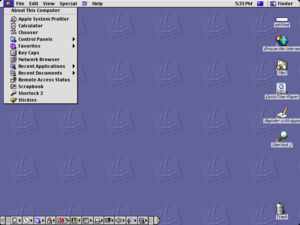Classic Mac OS
 |
|

Screenshot of Mac OS 9
|
|
| Developer | Apple Inc. |
|---|---|
| OS family | Macintosh |
| Working state | Historic, not supported |
| Source model | Closed source |
| Initial release | January 24, 1984 |
| Latest release | 9.2.2 / December 5, 2001 |
| Marketing target | Personal computing |
| Platforms | |
| Kernel type | Monolithic for 68k, nanokernel for PowerPC |
| Default user interface | Graphical |
| License | Commercial software, proprietary software |
| Succeeded by | macOS (previously named "Mac OS X" and "OS X") |
| Support status | |
| Unsupported as of February 1, 2002 | |
The "Classic" Mac OS is a graphical user interface-based operating system developed by Apple Inc. for its Macintosh line of personal computers from 1984 until 2001, the original member of the family of Macintosh operating systems. The Macintosh platform, which was introduced in the classic Mac OS, is credited with having popularized the early GUI concept. Mac OS was preinstalled on every Macintosh computer that was made during the era it was developed; it was also sold separately in retail stores.
Apple released the original Macintosh on January 24, 1984. Its early system software was partially based on the Lisa OS, previously released by Apple for the Lisa computer in 1983; as part of an agreement allowing Xerox to buy shares in Apple at a favorable price, it also used concepts from the Xerox PARC Alto computer, which former Apple CEO Steve Jobs and other Macintosh team members had previewed. The operating system integral to the Macintosh was originally named System Software, or simply "System", and referred to by its major revision starting with System 6 and System 7. Apple rebranded the system as Mac OS in 1996, starting officially with version 7.6, due in part to its Macintosh clone program. That program ended after the release of Mac OS 8 in 1997. The last major release of the system was Mac OS 9 in 1999.
Mac OS is characterized by its monolithic system. From its original release through System 4, it ran only one application at a time. Even so, it was noted for its ease of use. Mac OS gained cooperative multitasking with System 5, which ran on the Macintosh SE and Macintosh II. It was criticized for its very limited memory management, lack of protected memory, no access controls, and susceptibility to conflicts among extensions that provide additional functionality such as networking or support for a particular device.
...
Wikipedia
